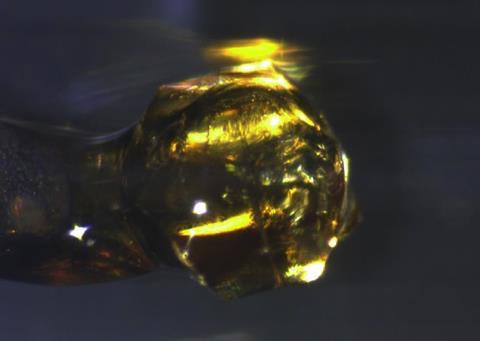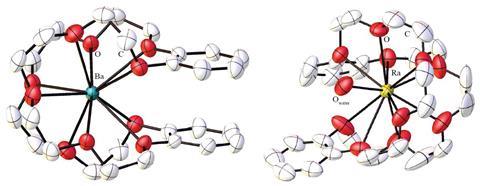A team at Oak Ridge National Laboratory (ORNL) in the US has reported the first synthesis and characterisation of a molecular radium compound by single crystal x-ray diffraction. The findings reveal the element’s coordination chemistry and could help develop new radium-based treatments for cancer.
The work, which has yet to be peer reviewed, builds on previous research at ORNL to develop drugs for an emerging type of cancer treatment known as targeted alpha therapy. This treatment uses alpha emitters such as radium to kill tumour cells, and the team aims to design new chelating molecules for radium so it can be delivered directly to tumour sites. Yet little is known about the fundamental structure and bonding interactions of radium compounds – even 125 years after its discovery – because it is only available in small amounts and it is highly radioactive.

‘When we look at other elements, there are tens, hundreds, and even thousands of crystal structures of complexes that have been reported to date, but with radium there was none for all of these years because radium is challenging to work with,’ medicinal chemist Nikki Thiele, who co-authored the research, tells Chemistry World. ORNL staff scientist Frankie White, who also co-authored the preprint, adds that radium’s size makes it difficult to bind to organic molecules.
The team had to develop a nanogram-scale synthesis and crystallisation process for its radium complex, which it first optimised by using barium – radium’s nearest group 2 neighbour – as a stand-in for radium. ‘We took a crown ether, a molecular compound that contains oxygen atoms, and coordinated that to the radium ion,’ White explains. Then it was a race against time to crystallise the complex and perform the x-ray diffraction before the sample was destroyed by its own radiation – the first crystals formed after 21 hours already showed signs of degradation.

The study’s results provide an important insight into radium’s chemistry. Up to now, researchers have used barium to make assumptions about radium’s interactions, yet the crystal structure of the equivalent barium–crown ether complex showed significant differences. ‘There’s certainly a small difference in ionic radii between barium and radium, in that radium is just slightly larger than barium, but it’s not clear if that small difference can fully explain the differences that we’re seeing in the solid-state structure here,’ says White. Therefore, using barium as a surrogate for radium means ‘you are essentially designing chelators for barium and not optimising them for radium,’ Thiele warns.
The ORNL team is hopeful that its method will guide the efforts of other researchers in radium chemistry. ‘Currently researchers have to take an outside-in approach for developing chelators for radium,’ White explains. ‘But when we have solid state studies, we can look at precise bonding interactions between radium and those heteroatoms such as oxygen and nitrogen, to really develop an inside-out approach to developing chelators.’
Complex chemistry
Gauthier Deblonde, a radiochemist in the nuclear and chemical sciences division of Lawrence Livermore National Laboratory in California who was not involved in the research, says he is ‘really excited’ about this latest preprint. ‘The new study is a veritable tour de force because the ORNL team managed to crystallise a pure radium compound and determined its single crystal XRD structure,’ he tells Chemistry World.
Justin Wilson, a coordination chemist at Cornell University in New York who works on developing radiopharmaceutical agents, adds that the study’s biggest impact is showing the shortcomings of using barium as a surrogate for radium. ‘A lot of our chemical intuition of radium is basically dictated by the way that barium behaves,’ Wilson says. ‘What’s cool about this study is … that the radium complex attained a substantially different conformation compared to the barium complex.’
The ORNL researchers now hope to fill in more of the gaps in our knowledge of radium. ‘We don’t want to just stop at this one compound,’ White says. ‘This complex is just one example of how radium binds with one specific molecule, and so to further extend that database of radium bonding, we need to synthesise and crystalise more structures.’
References
FD White et al, Nat. Chem., 2023, DOI: 10.1038/s41557-023-01366-z
A Ivanov et al, Chem. Commun., 2022,58, DOI: 10.1039/D2CC03156F

















No comments yet